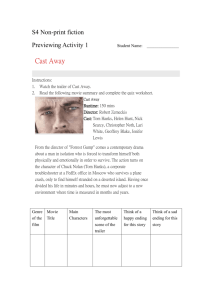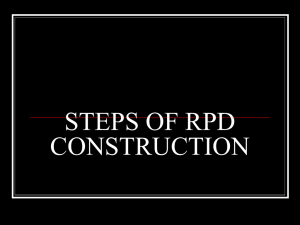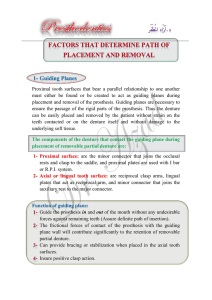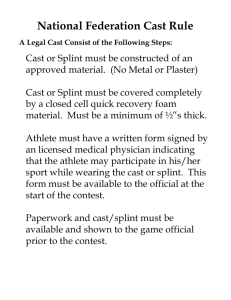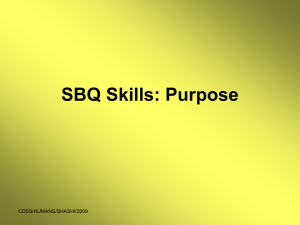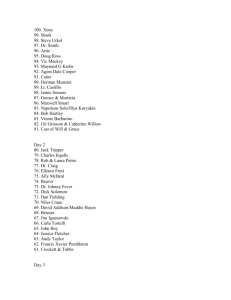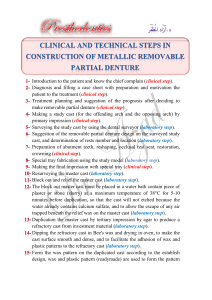Document 12822787
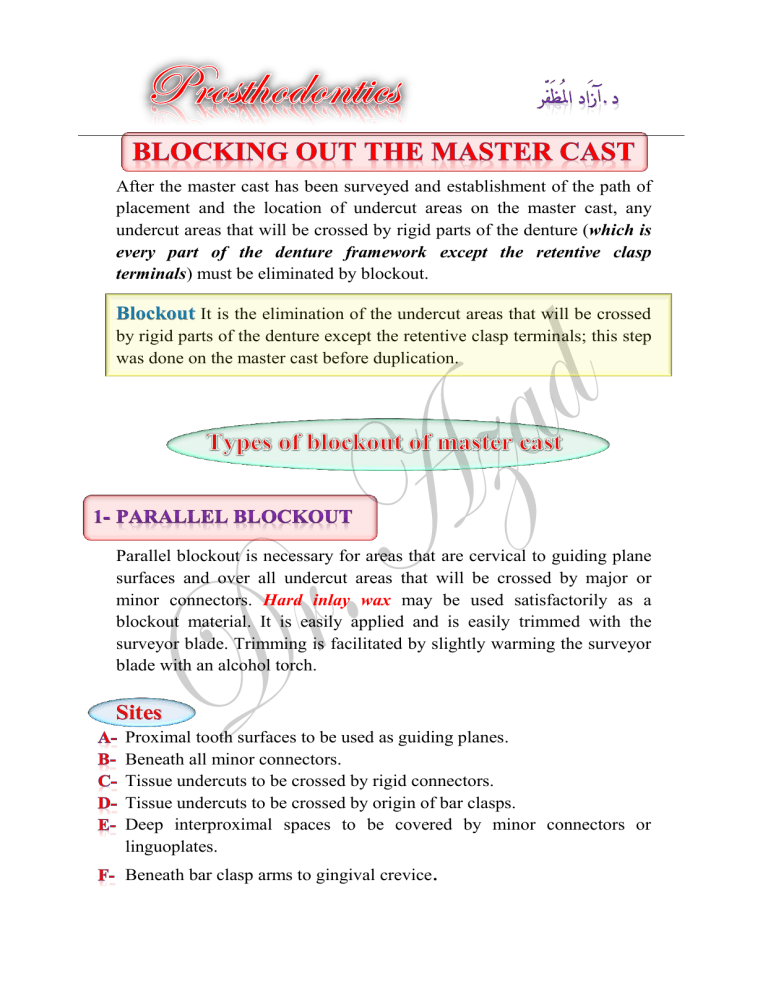
After the master cast has been surveyed and establishment of the path of placement and the location of undercut areas on the master cast, any undercut areas that will be crossed by rigid parts of the denture ( which is every part of the denture framework except the retentive clasp terminals ) must be eliminated by blockout.
Blockout
It is the elimination of the undercut areas that will be crossed by rigid parts of the denture except the retentive clasp terminals; this step was done on the master cast before duplication.
Parallel blockout is necessary for areas that are cervical to guiding plane surfaces and over all undercut areas that will be crossed by major or minor connectors. Hard inlay wax may be used satisfactorily as a blockout material. It is easily applied and is easily trimmed with the surveyor blade. Trimming is facilitated by slightly warming the surveyor blade with an alcohol torch.
Sites
Proximal tooth surfaces to be used as guiding planes.
Beneath all minor connectors.
Tissue undercuts to be crossed by rigid connectors.
Tissue undercuts to be crossed by origin of bar clasps.
Deep interproximal spaces to be covered by minor connectors or linguoplates.
Beneath bar clasp arms to gingival crevice
.
All guiding plane areas must be parallel to path of placement, and all other areas that will be contacted by rigid parts of denture framework must be made free of undercut by parallel blockout.
For locating clasp patterns may or may not be used. However, this should not be confused with the actual blocking out of undercut areas that would offer interference to the placement of the denture framework.
Site
On buccal and lingual surfaces, to locate the wax patterns for clasp arms.
Wax ledge for reciprocal clasp arm as cervical as possible also ledge for location of retentive clasp arm, ledge is applied below the survey line around the abutment teeth. Wax ledges on buccal surfaces of premolar and molar abutments have been duplicated in refractory the cast for exact placement of clasp molar pattern and the premolar wrought wire clasp.
Such areas are the labial surfaces and labial undercuts not involved in the denture design and the sublingual and distolingual areas beyond the limits of the denture design. These are blocked out arbitrarily with hard baseplate wax , but because they have no relation to the path of placement, they do not require the use of the surveyor.
Arbitrary block out is done to:
1Facilitate the removal of the cast from the impression during duplication.
2Prevent distortion of duplicating mold when the master cast is removed.
Sites
All gingival crevices.
Gross tissue undercuts situated below areas involved in design of denture framework.
Tissue undercuts distal to cast framework.
Labial and buccal tooth and tissue undercuts not involved in denture design.
Relief
It is the procedure of placing wax in certain areas on the master cast before duplication, to create a raised area on the refractory cast.
Purpose of relief
To prevent tissue impingement resulting from rotation of the denture framework.
To prevent abrasion of the cast.
To create space for the acrylic resin (beneath the retentive ladder).
Sites
Beneath lingual bar connectors or the bar portion of the linguoplates concerning the relative slope of the alveolar ridge.
Areas in which major connectors will contact thin tissue, such as hard areas so frequently found on lingual or mandibular ridges and elevated palatal raphes and tori.
Beneath the ladder minor connectors for attachment of resin bases.
Adequate relief to avoid impingement is gained when tissue side of lingual bar is highly polished during finishing process.
Tissue stops are represented as ( 2 mm x 2 mm ) square cut in the relief wax over the ridge in distal extension areas.
Tissue stops are integral parts of minor connectors designed for retention of acrylic resin bases. They provide stability to the framework during the stages of transfer and processing. Tissue stops can engage buccal and lingual slopes of the residual ridge for stability.
They are particularly useful in preventing distortion of the framework during acrylic resin processing procedures, by holding the retention area of the framework (retentive ladder) away from the tissue while packing force is being applied.
Another integral part of the minor connector designed to retain the acrylic resin denture base is similar to a tissue stop but serves a different purpose.
It is located distal to the terminal abutment and is a continuation of the minor connector contacting the guiding plane. Its purpose is to establish a definitive finishing index tissue stop for the acrylic base after processing.
Duplication
is the procedure of accurately reproducing a refractory cast.
To preserve the original master cast.
On the duplicated cast the metal framework may be fitted without fracture or abrading the original master cast.
Refractory cast:
It is a cast made of material that will withstand high temperature without disintegration when used in partial denture casting procedure; it has an expansion to compensate for metal shrinkage. The refractory cast has been made of investment material .
On the duplicated cast the metal framework may be fitted without danger of fracture or abrading the surface of the original master cast.
An investment cast also may be referred to as a refractory cast because it is compounded to withstand high temperatures without disintegrating and, incidentally, to perform certain functions relative to the burnout and expansion of the mold. A refractory investment is an investment material that can withstand the high temperatures of casting or soldering.
The investment material is used for making the refractory cast; the type of investment depends on the type of alloy used.
Gypsum bounded investment is used for low heat alloys as type IV gold alloy .
Phosphate bounded investment is used for high heat alloys as vitallium , palladium alloy .
Investment is consisted of powder and special liquid is needed to be mixed with the powder, special flask that has been used for duplication, consist of bottom, ring, and feeding tube.
For duplication procedure a duplicating colloid have been used, this material is agar which reversible hydrocolloid that are capable of being reused up to four times, they may be prepared and stored in an automatic duplicating machine . A double boiler can be used to prepare the colloid for duplication. The clean colloid can be used by cutting it into small pieces, reheated in this double boiler to a fluid consistency, then tempered to a working temperature, it will be cooled enough to flow easily without melting the blocked out wax (63°C).

